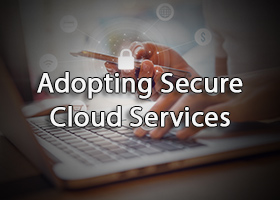
Healthcare providers must deliver end-to-end data security because they manage personally identifiable information and medical histories, both of which can be targeted by cybercriminals to steal patients’ identities or commit insurance fraud.
Patients rely on hospitals and medical centers to protect their privacy as well as their health. Healthcare providers need to find new ways to defend healthcare data against cybercriminals so patients can feel confident that their information is in the right hands.
Healthcare organizations can better protect data by embracing new trends in data security, such as encrypted waves, secure cloud services, and managed edge security.
Walking the Healthcare Security Tightrope
 The number of yearly security incidents involving healthcare organizations continues to climb. HIPAA Journal reported that the number of breaches has more than doubled year over year. In 2018, over 13 million medical records were compromised.
The number of yearly security incidents involving healthcare organizations continues to climb. HIPAA Journal reported that the number of breaches has more than doubled year over year. In 2018, over 13 million medical records were compromised.
HIPAA regulations require that healthcare organizations protect patient data while still allowing access for authorized users. Maintaining the balance between access and security can be tricky in the healthcare industry.
Catching Encrypted Waves
Most hospitals and medical centers already use encryption to protect data. However, many forms of encryption impede performance. The process of encryption can slow the transmission of data, creating latency. Healthcare providers need to transmit patient information quickly so that urgent medical decisions can be made.
Encrypted waves are a solution to the latency problem. Encrypted wavelength solutions protect data in flight without slowing transmission. Encryption occurs at the first layer, ensuring protection at the transport layer and across the organization.
Encrypted wavelength is ideal for protecting the kinds of latency-sensitive transmissions healthcare providers must handle. High-resolution medical scans can be transmitted quickly and reliably so that doctors can perform critical diagnoses.
Adopting Secure Cloud Services
 The cloud provides flexible and affordable data storage resources for healthcare organizations. Hybrid cloud, in particular, allows hospitals to use public cloud for patient-facing applications while storing sensitive data on-premises.
The cloud provides flexible and affordable data storage resources for healthcare organizations. Hybrid cloud, in particular, allows hospitals to use public cloud for patient-facing applications while storing sensitive data on-premises.
However, not every cloud provider will offer the same level of security. Protecting data as it moves to and from the cloud is also a concern. Cloud services should be supported by a network that resists interception by hackers. The right cloud provider will offer 24/7 physical and virtual security for electronic health records (EHRs).
Before choosing a cloud provider, hospitals and medical centers should ensure that the service level agreement (SLA) clearly spells out the security measures that will be provided and that these measures are adequate for the organization’s needs.
Leveraging Managed Edge Security
Healthcare organizations have begun to rely on mobile devices and the Internet of Things (IoT) to expand their reach and get patients more involved in their own care. IoT devices for healthcare include pacemakers and insulin pumps. Patients also use wearables to track vital signs, such as blood pressure, heart rate, and blood sugar levels.
The resulting proliferation of endpoints creates new security challenges for healthcare providers. When patient data is being generated by mobile devices and sensors on connected devices, it can’t be protected by firewalls. The sensitive data is outside the perimeter.
Adding to the risk, most IoT devices and wearables are not designed to protect against hacks. Security needs to be present at the edge to prevent data from being stolen or compromised before it reaches the database.
Managed edge security ensures the networks borders are secure. The solution allows for full visibility into the entire network, from the heart of the database to the farthest-flung endpoint. Like other managed services, managed edge security takes the burden of monitoring the network off your IT staff. Other edge security services can include firewall, intrusion detection, and content filtering.
Achieving Security and Performance
No doubt 2019 will present the toughest data security challenges healthcare providers have seen yet. Adopting new security strategies for an end-to-end approach should keep healthcare organizations ahead of the game.
Security solutions such as encrypted waves will enable hospitals and medical centers to protect data while still maintaining the performance and availability levels necessary to access and analyze patient data.
FirstLight has a long and successful track record of helping healthcare providers in the Northeast transmit medical data rapidly and safely. Our cloud solutions undergo a HIPAA audit every year to ensure we enforce compliance for our clients.
You can read about how we helped Schenectady Radiologists, PC (SRPC Medical Imaging) and ConvenientMD Urgent Care use fiber optics, encrypted wavelength, and the cloud to achieve more robust data security for their patients.
Take advantage of the latest data security strategies. Team up with FirstLight today.





















